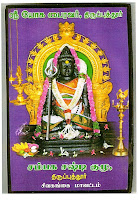Bhairava
("Terrible" or "Frightful"), sometimes known as Bhairo or Bhairon or Bhairadya, is the fierce manifestation of Shiva associated with annihilation.He is one of the most important deities of Nepal, sacred to Hindus alike.
He is depicted ornamented with a range of twisted serpents, which serve as earrings, bracelets, anklets, and sacred thread (yajnopavita). He wears a tiger skin and a ritual apron composed of human bones. Bhairava has a dog as his divine vahana (vehicle).
Bhairava himself has eight manifestations: Kala Bhairava, Asitanga Bhairava, Samhara Bhairava, Ruru Bhairava, Krodha Bhairava, Kapala Bhairava, Rudra Bhirava and Unmatta Bhairava. Kala Bhairava is conceptualized as the Guru of the planetary deity Saturn. Bhairava is known as Vairavar in Tamil where he is often presented as a Grama Devata or folk deity who safeguards the devotee on all eight directions (ettu tikku). Known in Sinhalese as Bahirawa, he protects treasures. Lord Bhairava is the main deity worshipped by the cannibalistic Aghora sect.
 The origin of Bhairava can be traced to the conversation between Lord Brahma and Lord Vishnu recounted in "Shiv Maha-Purana" where Lord Vishnu asks Lord Brahma who is the supreme creator of the Universe. Arrogantly, Brahma tells Vishnu to worship him because he (Brahma) is the supreme creator. This angered Shiva who in reality is the creator of all. Shiva then incarnated in the form of Bhairava to punish Brahma. Bhairava beheaded one of Brahma's five heads and since then Brahma has only four heads. When depicted as Kala Bhairava, Bhairava is shown carrying the amputated head of Brahma. Cutting off Brahma's fifth head made him guilty of having slain brahma, and as a result, he was forced to carry around the head for years until he had been absolved of the sin.
The origin of Bhairava can be traced to the conversation between Lord Brahma and Lord Vishnu recounted in "Shiv Maha-Purana" where Lord Vishnu asks Lord Brahma who is the supreme creator of the Universe. Arrogantly, Brahma tells Vishnu to worship him because he (Brahma) is the supreme creator. This angered Shiva who in reality is the creator of all. Shiva then incarnated in the form of Bhairava to punish Brahma. Bhairava beheaded one of Brahma's five heads and since then Brahma has only four heads. When depicted as Kala Bhairava, Bhairava is shown carrying the amputated head of Brahma. Cutting off Brahma's fifth head made him guilty of having slain brahma, and as a result, he was forced to carry around the head for years until he had been absolved of the sin. Another story of the origin of Bhairava is the tale of Sati, wife of Shiva. Sati, the daughter of the king of gods, Daksha, had chosen to marry Shiva. Her father disapproved the alliance because he perceived Shiva as an ascetic associated with a frugal lifestyle, forest animals and ghosts. Eventually, Daksha held a yagna (a ritualistic sacrifice) and invited all the gods, but not Sati and Shiva. Sati came to the yagna alone, where Daksha publicly spoke in a belittling manner about Shiva. Sati could not bear to hear her husband insulted and offered herself to the sacrificial pyre.
Another story of the origin of Bhairava is the tale of Sati, wife of Shiva. Sati, the daughter of the king of gods, Daksha, had chosen to marry Shiva. Her father disapproved the alliance because he perceived Shiva as an ascetic associated with a frugal lifestyle, forest animals and ghosts. Eventually, Daksha held a yagna (a ritualistic sacrifice) and invited all the gods, but not Sati and Shiva. Sati came to the yagna alone, where Daksha publicly spoke in a belittling manner about Shiva. Sati could not bear to hear her husband insulted and offered herself to the sacrificial pyre.When Shiva learned of this, he destroyed the yagna and killed Daksha by beheading him. Shiva carried Sati's corpse on his shoulders and ran uncontrollably all around the world for days. Since this would eventually destroy all creation, Vishnu used his Sudarshan Chakra (divine discus) to cut Sati's body into pieces, which then fell all around. These spots where Sati's body parts fell are now known as Shakti Peethas. In the form of the frightful Bhairava, Shiva is said to be guarding each of these Shaktipeeths. Each Shaktipeeth temple is accompanied by a temple dedicated to Bhairava.
Image2: Swarnakarshna Bairavar
Image3: Kasi Kala Bairavar
Image4: Sri Kala Bairavar
Image5: Bairavar - Tiruvallam
Image6: Bairavar - Irudayaleeswarar Temple, Tiruninravur
Image8: Sri Chadurkala Bairavar
Image9: Chakra Bairavar - Tiruvanamalai
Image10: Bairavar - Marundeeswarar Temple
Image11: Sri Yoga Bairavar - Tiruputhur
Image12: Yoga Bairavar - Perur
Image13: Bairavar - Somangalam
Image14: Bairavar - Kuberan Temple














